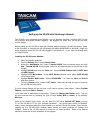
Setting up the US-428 with Steinberg’s Nuendo
The US-428 is fully supported under Nuendo v1.xx for Windows and Mac, including ASIO 16 and
24 bit drivers and control surface mapping. We suggest you make sure you’ve got the most
current update.
Before setting up the US-428 to work with Nuendo, please install the US-428 v3.0 drivers. (Refer
to the document on installing the US-428 drivers with either Win98SE/ME or Win2000.) Begin the
setup procedure below with the US-428 plugged in and power on. If you have not already done
so, install Nuendo.
Installing the US-428 under Nuendo:
• Open the Nuendo application
• From the DEVICES menu, choose DEVICE SETUP.
• Select the ADD/REMOVE tab. Select “TASCAM US-428” from the device menu and click
ADD. TASCAM US-428 should appear on the list of loaded devices on the left side of the
window.
• Highlight US-428 and click the SETUP tab. Select US-428 CONTROL PORT for MIDI INPUT
and MIDI OUTPUT.
• Highlight VST MULITITRACK. In the ASIO DRIVER pull-down menu, select ASIO US-428
(16- or 24-bit) driver.
• Highlight DEFAULT MIDI PORTS. Select US-428 MIDI 1 or 2 from the INPUT and OUTPUT
drop-down menus.
• From the DEVICES menu, choose VST INPUTS. Make sure at least one pair of inputs for
the US-428 are set to active.
If you’re running Nuendo for the first time, you’ll need to create a new project. Select FILE/NEW
PROJECT, and choose EMPTY PROJECT.
You’ll then need to add tracks to the project. Select the PROJECT/ADD TRACKS menu. This can
be done one-at-a-time by choosing the type of track (AUDIO, MIDI or GROUP), or by selecting
MULTIPLE.
Once you’ve created Audio tracks, you can open the VST Mixer (DEVICES/VST MIXER, or press
F1 on the US-428 or F3 on your computer keyboard). You should have control of Nuendo’s
faders, mutes, transports and other basic functions, as well as EQ and Aux sends. The controller
mapping for the US-428 within Nuendo lagely follows the same protocols as Cubase and
Cubasis. Refer to the US-428 manual for more info on these functions. Refer to the Nuendo
manual for more info on basic operations of the program.



